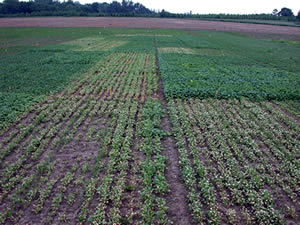Clarence J. Swanton

Email:
Phone:
Education:
B.Sc. in Botany
University of Toronto;
M.Sc. in Agrometeorology
University of Guelph;
Ph.D. in Plant Ecology
University of Western Ontario
Location:
Room:
Clarence Swanton is a weed scientist in the Department of Plant Agriculture. Between earning his M.Sc. and Ph.D., he was employed as a field agronomist with the Campbell Soup Company, and later as a weed biologist with the Ontario Ministry of Agriculture and Food. In 1985 he joined the University of Guelph as a faculty member, and was promoted to full professor in 1996. Clarence served as the first Chair of the Department of Plant Agriculture from 1998 to 2004, and was president of the Canadian Weed Science Society from 2007 to 2008.
Affiliations and Partnerships
- Fellow of the Canadian Society of Agronomy
- Fellow of the Canadian Weed Science Society
- Fellow of the Weed Science Society of America
Awards and Honours
- Elected to the Waterford District High School Hall of Fame (2011)
- Outstanding Canadian in Crop Protection (2013)
- Weed Science Society of America’s Outstanding Researcher Award (2002)
Research Impact
Clarence’s research team ultimately seeks to generate new knowledge that can be used to improve productivity and profitability of the agriculture industry while simultaneously reducing its environmental footprint. His team performed the original work involved in developing the integrated weed management strategies now used for field crops grown in Ontario. His research is highly cited globally, demonstrating a significant impact on international study and he attends many local and international grower meetings as an invited speaker.
Current Research Projects
How can we solve issues of herbicide resistance in both field crops and minor crops?
Clarence’s team works closely with industry to develop new herbicides and alternative strategies for Canadian growers. One example can be found in a current project that involves the study on the control of linuron-resistant weeds that infest crops grown in the Holland Marsh area of Ontario. Clarence’s work seeks to provide alternative strategies for growers in this region to combat this issue. This research encompasses applied research in weed science in an effort to provide solutions to a significant on-farm problem. This project is supported by The Ontario Ministry of Agriculture and Rural Affairs, Fresh Vegetable Growers of Ontario, The Holland Marsh Vegetable Growers’ Association and Syngenta Canada
What are the mechanisms of plant competition? Does plant communication play a role?
One important area that Clarence’s team has specialized in within weed science is the concept of plant competition, an important cause of yield loss. Previously, plant competition was thought to be the result of limited resources such as water, light and nutrients. Clarence’s work, however, suggests that early season weed-crop competition is actually caused by an energy imbalance in the plants themselves. His research works to build upon current understanding of the mechanisms of competition by studying plant communication and its impacts on plant physiology. His team is particularly concerned with determining how a plant detects a weed and whether or not it is able to detect its own siblings. Discoveries in this area could provide information for the development of crops with higher weed tolerance that can better withstand competition. This project is funded by a NSERC Discovery Grant
How can we use technology to solve issues of plant stress?
In collaboration with the University of Waterloo, this project explores the possibilities of precision agriculture. The goal of this research is to develop new technology that uses the thermodynamic concept of exergy to rapidly detect stressed plants in the field and utilize GPS for their treatment. Field trials were established at the Elora and Woodstock Research Stations to determine if differences in soil nitrogen content or varying levels of weed control can create a measurable physiological stress on corn plants. This research is funded by the Grain Farmers of Ontario.

Graduate Student Information
Available graduate student positions in the Department of Plant Agriculture can be found on the department’s Employment Opportunities website.
Clarence’s research teams are composed of post-doctorate and graduate students as well as technicians. Graduate students are given the opportunity to explore literature and develop hypotheses and working methodologies. They are encouraged to contribute to project development and are afforded independence in their studies.
Clarence strongly believes in two key principles for success as a graduate student. First, the student must be excited about the project; they will experience highs and lows during the course of their project, and having a strong enthusiasm for the topic will sustain them throughout. Second, the student should connect well with their supervisor and enjoy working with them. Having both of these pieces in place will make the project more enjoyable and less of a challenge when roadblocks occur. Clarence follows his students through their careers and makes every effort to profile and provide networking opportunities to assure employment and future success.
Clarence’s past graduate students have worked on projects involving novel discoveries in mechanisms of plant communication and competition, seed treatments that alter gene expression and the design of control solutions for on-farm problem solving. Past students have gone on to faculty positions in Canada and the United States and to roles in government and the crop protection industry.
Courses:
Relevant Links:
Selected Publications:
House,M.A., C.J. Swanton and L.L. Lewis. 2020. The neonicotinoid insecticide thiamethoxam enhances expression of stress response genes in Zea mays in an environmentally specific pattern. Genome 2020 https://doi.org/10.1139/gen-2020-0110
Vanhie, T.R., F.J. Tardif, P. Smith, S. Vazan, M. Cowbrough, and C.J. Swanton. 2020. An integrated weed management strategy for the control of horseweed (Erigeron canadensis). (Accepted Nov. 30 Weed Science)
McKenzie-Gopsill A., S. Amirsadeghi, S. Fillmore, C.J. Swanton. 2020. Duration of weed presence influences the recovery of photosynthetic efficiency and yield in common bean (Phaseolus vulgaris L.). Frontiers in Agronomy 2020. https://doi.org/10.3389/fagro.2020.593570
Alzaben, H., R. Fraser and C. Swanton. 2019. An inverse correlation between corn surface temperature and nitrogen stress: a field case study. Agronomy Journal 111: 3207-3219
McKenzie-Gopsill A G, S Amirsadeghi, H J Earl, A M P Jones, L Lukens, E Lee, C J Swanton. 2019. Early physiological and biochemical responses of soyabean to neighbouring weeds under resource-independent competition. Weed Research 59: 288-299.
Gonnzalas V. E. Lee, L.Lukens and C.J. Swanton. 2019 The relationship between floret number and plant dry matter accumulation varies with early season stress in maize (Zea mays L.). Field Crops Research 238: 129-138.
de Boer, T., P.Smith, K. Chandler and C.J. Swanton. 2019. A linuron-free weed management strategy for carrots. Weed Technology 33:464-474.
Bahadur, K., et al. 2018. When too much enough isn’t: Does current food production meet global nutritional needs? PLOSone (13) 10:e0205683 https//doi.org/10.1371/journal.pone.0205683
Campmourtes, V., J. Adams, A. Berg, E. Fraser, C. Swanton and M. Anand. 2018. Precision conservation meets precision agriculture: a case study from southern Ontario. Agricultural Systems 167:176-185.
Westwood, J.H., R. Charudattan, S.O. Duke, S.A. Fennimore, P. Marrone, D.C. Slaughter, C. Swanton and R. Zollinger. 2018. Weed management in 2050: Perspectives on the future of weed science. Weed Science 66: 275-285. (Invited)
Underwood, M., N. Soltani, D.C. Hooker, D.E. Robinson, J. Vink, C. Swanton and P.H. Sikkema. (2017). Benefit of tank-mixing dicamba with glyphosate applied post-emergence for weed control in dicamba plus glyphosate resistant soybean. Canadian Journal of Plant Science.
Murphy, G.P., R. Van Acker, I. Rajcan and C.J. Swanton. (2017). Identity recognition in response to different levels of genetic relatedness in commercial soya bean. Royal Society Open Science. 4 (1): 160879.
Kim, H.W., S. Amirsadeghi, M. Afifi, G. Bozzo, E. A. Lee, L. Lukens and C. J. Swanton. (2016). Changes in light quality alter physiological responses of soybean to thiamethoxam. Planta. 244 (3).
McKenzie-Gopsill, A.G., E. Lee, L. Lukens, and C.J. Swanton. (2016). Rapid and early changes in morphology and gene expression were detected in soyabean seedlings emerging in the presence of above ground weeds. Weed Research. 56 (4).
Gall, J., M. Afifi, E. Lee, L.Lukens and C. Swanton. (2015). Detection of neighboring weeds alters soybean seedling roots and nodulation. Weed Science. 63: 888-900.
Afifi, M., E. Lee, L. Lukens and C.J. Swanton. (2015). Maize (Zea mays) seeds can detect above ground weeds; thiamethoxam alters the view. Pest Management Science. 71: 1335-1345.
Nkoa, R., M.D.K. Owen and C.J. Swanton. (2015). Research Methods in Weed Science: Weed Abundance, Distribution, Diversity and Community Analyses. Weed Science. Special Issue: 64-90. Invited.
For a full list of Clarence’s publications, please visit his Google Scholar page.
